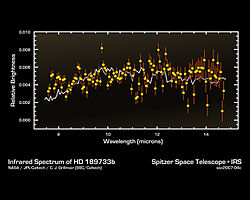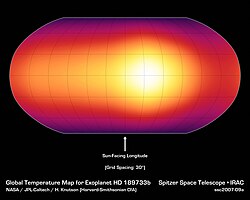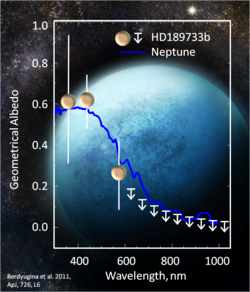ホット・ジュピター
出典: フリー百科事典『ウィキペディア(Wikipedia)』 (2023/12/10 01:02 UTC 版)
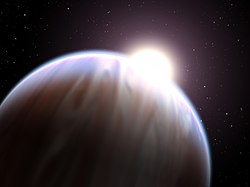
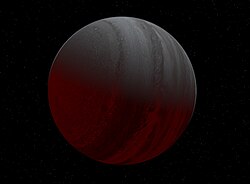
主星の近くを高速で公転しているため、質量が大きい惑星の重力によって生じる主星のわずかな揺れを検出するドップラー分光法での発見が最も簡単なタイプである。最もよく知られているホット・ジュピターは1995年に発見されたペガスス座51番星bであり、太陽に似た恒星をわずか4日間で公転している。
ホット・ジュピターは比較的発見が容易であることから、系外惑星の探査の初期から多数が発見された。その他には軌道離心率の大きい彗星のような楕円軌道を描き、灼熱期と極寒期をめまぐるしく繰り返す巨大惑星エキセントリック・プラネットも発見されたが、いずれも太陽系には存在しない種類の惑星であり、これらの系外惑星の発見は既存の惑星形成理論に大きな転換をもたらした[8][9]。
特徴
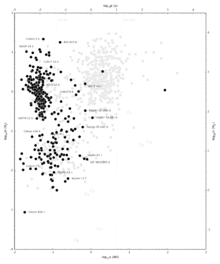
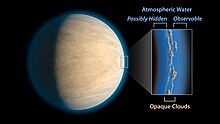
一般的な特徴
ホット・ジュピターの中には様々なものがあるが、いくつかの共通した性質を持っている。
- 定義ともいえる特徴は、質量が大きく、短周期で公転している事である。質量は0.36-11.8MJで、公転周期は 1.3-111 日にわたる[11]。質量が13.6木星質量を超えると重水素の核融合反応が始まって褐色矮星となってしまうため、ホット・ジュピターに分類される天体の質量はこれよりも軽い[12]。
- 密度が異常に低い事が多い。2007年までに発見されているホット・ジュピターの中で最も低密度の惑星は、TrES-4 の 0.222 g/cm3 であった[14]。その後さらなる低密度の惑星が続々と発見されており、例えば HAT-P-67b は質量が0.34木星質量だが半径は2.085木星半径もあり、密度はわずか 0.052 g/cm3 である[15]。ホット・ジュピターの半径が質量の割に大きい理由は完全に分かっていないが[16]、主星からの強い輻射の影響や、大気の不透明度が大きいこと[17]、内部に加熱源を持っている可能性、主星に十分に近いため惑星の外層がロッシュ・ローブを超えて流出してしまうからなど、複数の理由が考えられている[14][16][17]。
- 公転周期が短く、潮汐固定されているため、極端で変わった大気を持っている可能性がある。大気の力学モデルは、大気は鉛直方向に強く成層し、放射強制力と熱・運動量の輸送によって駆動される強い風と自転速度を超える赤道ジェット (スーパーローテーション) を起こしていることを予測する[19][20]。光球での昼と夜の温度差は大きいと予測されており、HD 209458bに基づくモデルではおよそ 500 K の温度差があるとされる[20]。
存在割合
太陽系外惑星の観測が可能となった初期の時代には観測バイアスのために高い割合でホット・ジュピターが発見されていたが、現在では木星のような低温の巨大ガス惑星(クール・ジュピター)と比べて珍しい天体だと考えられている[21]。ケプラー宇宙望遠鏡のトランジット法による観測によれば、太陽に似た恒星(F型主系列星・G型主系列星・K型主系列星)のうち、ホット・ジュピター(公転周期10日以下・半径が地球の6~22倍)を持つ恒星は全体の0.43±0.05%に過ぎない[22]。地上の望遠鏡を用いた視線速度法のサーベイでは、異なるチームによって0.89±0.36%(周期11日以下・50地球質量以上)[23]や1.20±0.38%(周期10日以下・30地球質量以上)[24]という値が報告されている。
ホット・ジュピターの存在割合は主星の性質によって大きく左右される。ホット・ジュピターの主星はF型主系列星、G型主系列星である事が多く、K型主系列星の周りでの発見例は比較的少ない。赤色矮星に関しては、極めて稀である[25]。ホット・ジュピターの存在分布の一般化に関しては様々な観測バイアスを考慮する必要があるものの、一般的には恒星の絶対等級が大きくなる (つまり恒星が暗く、軽くなる) につれて、ホット・ジュピターの存在割合は指数関数的に減少する[26]。またホット・ジュピターの存在と主星の金属量にも強い正の相関関係が知られている[27]。
軌道
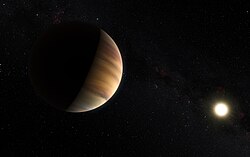
我々の太陽系においては、比較的小型な地球型惑星(岩石惑星)が太陽に近い軌道をめぐっている一方、木星・土星のような木星型惑星(特に巨大なガス惑星)は太陽から数 au から数十 au の距離を隔てて公転している。これらの外惑星は、太陽の熱を十分に受け取ることができないため、表面温度零下百数十度の極寒の世界となっている。
しかし、典型的なホット・ジュピター (ペガスス座51番星bなど) は中心の恒星からわずか 0.05 au 程度しか離れていない[2]。中心の恒星が太陽と同じ明るさを持つとすると、この軌道を周回する惑星が単位面積あたり恒星から受け取る光のエネルギーの量は、地球の数百倍にも達する計算になる。そのため惑星表面は熱せられて摂氏数百度を超える高温となっている。かつては太陽系以外の恒星系も惑星の配置・構成は先に述べたような太陽系の姿とさして変わらないだろうと思われてきたが、実際の系外惑星はほとんどの学者が予想だにしない形で発見され、大きな衝撃を与えた[8][28]。
なお、惑星の居住可能性を論じる場合において、木星や土星のようなハビタブルゾーンの外側を回る木星型惑星をホット・ジュピターとの対比で「グッド・ジュピター」と呼ぶことがある[29]。ただし、ここで「グッド(good)」とは、その巨大な重力で太陽系外縁方向から飛来する彗星などを捕らえて、内惑星に影響を及ぼしにくくするという意味が含まれている。事実、20〜21世紀のわずか17年間にも、シューメーカー・レヴィ第9彗星などいくつかの彗星及び類似の天体が木星に捕らえられるのが観測されている[30]。
質量と大きさ
恒星に近い軌道を周回する惑星は、主系列星を公転する系外惑星が初めて発見された1995年以降多数発見されている。これらの惑星の質量は、惑星と褐色矮星の境界付近の大質量のものから、地球の程度のものまで様々である。ホット・ジュピターの質量に特に厳密な定義があるわけではないが、これらの惑星のうち木星の 0.1〜0.2 倍程度以上の質量を持つものをホット・ジュピターと呼ぶのが一般的である[31]。木星の質量 (地球の 318 倍) よりもむしろ海王星の質量 (地球の 17 倍) に近い、0.03〜0.1木星質量程度の低質量の灼熱惑星は、ホット・ジュピターではなくホット・ネプチューンと呼ばれる[32]。
広く系外惑星の検出に使われている観測方法である視線速度法では、惑星の質量は分かっても惑星の半径までは知ることはできない。視線速度法から分かるのはその惑星の下限質量である[33]。しかしその後、いくつかの惑星のトランジット法による観測が行われると、惑星の半径を計測することが可能になった[34]。求められたホット・ジュピターの半径は、太陽系の木星や土星と比べると、質量の割には大きいという傾向がある。これは高温によって惑星の大気が膨張しているためだと考えられている[14][17]。
大気
ホット・ジュピターはガス惑星であり、いわゆる大気で覆われている。恒星に極めて近い軌道を持つため、潮汐力によって自転と公転が同期し、地球の周りを回る月と同じように、常に同じ面を恒星に向ける。すると、一方の半球面が常に恒星光で熱せられ、温度差によって常に影の半球面に向かって摂氏数百度を超える強烈な熱風が吹いていると予想されている。そのため、ホット・ジュピターの外観は木星のような横縞模様ではなく、恒星の光が最も強く当たる点から影の面へ向かう気流により縦方向の縞模様が形成され、スイカの模様のようになっているとも推定されていた。しかしホットジュピターは、太陽系のガス惑星と比べると遅いとはいえ、公転周期と同じ周期で自転もしているため、きれいにスイカの模様状の大気の流れが生じるかは疑問視されている。
近年のコンピュータシミュレーションを用いた研究では、ホット・ジュピターのように恒星に非常に近く、潮汐固定されているため自転が遅い惑星では、大気の循環は金星のようなスーパーローテーションになっている可能性が指摘されている[37]。常に恒星の方を向いている半球では恒星からの強い輻射を受けて大気が加熱され、東向きに強く加速されて赤道ジェットを形成する。高速の大気流はそのまま夜側の半球へと流れ、放射で冷却しながら再び昼側へと循環する。これによって昼側と夜側とで効率的に熱が輸送されていると考えられる[37]。いくつかのホット・ジュピターのトランジットおよび二次食の観測でも、強い東向きの赤道ジェットが存在することを示唆する結果が得られている[37][35]。
惑星自体の色は、あまりの高温のために水蒸気のような揮発性の高い成分は存在せず、鉄のような固体成分が蒸発して透明なガス成分のみになっているため、深い青い色に見える可能性も指摘されている。これは本来透明な海水や大気が日光の散乱によって青く見えるのと同じ現象である。ただしひと口にホット・ジュピターと言ってもその温度は様々であるため、鉄などの金属も蒸発してしまうほどの高温の大気や、岩石成分の雲が存在する大気など、多様な特徴を持つと考えられている[38]。2013年にはハッブル宇宙望遠鏡を用いてホット・ジュピター HD 189733 b の二次食の分光観測が行われ、この惑星が深い青色をしていることが判明した[39][36][40]。系外惑星の色が観測的に判明したのはこれが初めてである[40]。この惑星が深い青色をしている明確な理由は分かっていないが、大気中に存在するケイ酸塩の粒子による青い光の散乱が原因だと推測されている[36][40]。
その他、恒星から強力な宇宙線が大気に降り注いで衝突しているため、明るいオーロラや、それに伴う強い電波放射が発生している可能性がある[41]。また惑星 HD 209458 b では大気の流出が観測されたほか[42]、大気の成分が調べられている[43]。
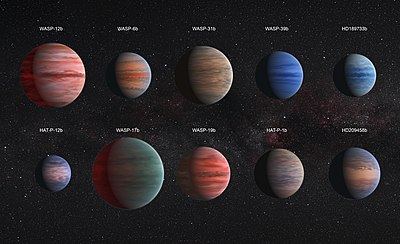
左上から右下へ、WASP-12b、WASP-6b、WASP-31b、WASP-39b、HD 189733 b、HAT-P-12b、WASP-17b、WASP-19b、HAT-P-1b、HD 209458 b。
発見
従来、太陽系以外の恒星にも惑星は存在するだろうと言われており[44]、1940年代から様々な系外惑星探査(プラネット・ハンティング)の試みがなされてきた。しかし、バーナード星などいくつかの恒星で惑星の発見が報告されたものの[45][46]、後にいずれも否定され[47]、太陽系の外の惑星は幻のままであった。SFの世界では多種多様な系外惑星が頻繁に登場するが[44]、初めて現実に太陽系以外の恒星に惑星が発見されたのはようやく1990年代になってからである (詳細は太陽系外惑星の項を参照)[48]。
1995年10月6日、ジュネーブ天文台のミシェル・マイヨール、ディディエ・ケローらスイスの観測チームによって、ペガスス座51番星 (51 Pegasi) に木星の半分の質量を持った巨大惑星ペガスス座51番星bの存在が確認された[49]。この惑星の軌道は、中心の恒星からわずか 0.05 au (約750万 km) しか離れておらず、水星軌道よりも遙かに内側であり (水星の軌道半径の八分の一)、恒星のまわりを 4.2 日で周回していることも確認された[49]。この発見は様々な検証を経て間違いなく系外惑星であると確かめられ、これをきっかけとして系外惑星探査に火がついた[48]。ペガスス座51番星b の発見を皮切りに、他の恒星にも木星型惑星が続々と発見された。ペガスス座51番星の系外惑星は決して特殊な例ではなく、同様のホット・ジュピターの発見が相次いでいる。
従来の系外惑星探査は、ほとんどの観測者が太陽系に似た恒星系を想定して探していたため、観測データには既にかかっていたにもかかわらず、思わぬ盲点となって見落としてしまったようである[48]。太陽系を基準に他の恒星系を考えるという先入観・常識は覆された。
系外惑星探査が本格化した後、初めのうちに発見された系外惑星は、先述したように大半がホット・ジュピターあるいはエキセントリック・プラネットであったが、これは宇宙に散らばる恒星のほとんどがそうした灼熱巨大ガス惑星を擁しているというわけではない。大部分の巨大惑星は重力による恒星のふらつきを検出するという方法で観測されているが、恒星のふらつきは質量が大きく恒星と惑星の距離が短いほど大きくなるため、ホットジュピターのような重い惑星は最も検出が容易である[8]。また、公転周期の短さゆえに観測や確認が短時間ですむという事情もあった。トランジット法での惑星検出も同様で、ホット・ジュピターのように恒星に近く、比較的サイズの大きい惑星は検出されやすいという観測バイアスが存在する。そのため初期に発見された系外惑星はホット・ジュピターが多かったが、観測技術が発展するのに伴い、より恒星から離れた軌道を持つ惑星や小さい惑星も多く発見されるようになった。
注釈
出典
- ^ 井田茂 2003, p. 12.
- ^ a b Mathiesen, Ben (2006年3月19日). “'Hot Jupiter' Systems may Harbor Earth-like Planets”. PhysOrg.com. 2019年4月4日閲覧。
- ^ Sharp, A. G.; Moses, J. I.; Friedson, A. J.; Fegley, B.; Marley, M. S.; Lodders, K. (2004). “Predicting the Atmospheric Composition of Extrasolar Giant Planets”. 35th Lunar and Planetary Science Conference (Lunar and Planetary Science Conference) 35: 1152. Bibcode: 2004LPI....35.1152S.
- ^ Darling, David. “epistellar jovians”. The Internet Encyclopedia of Science. 2019年4月4日閲覧。
- ^ "Interiors of extrasolar planets: A first step" (PDF) (Press release). Astronomy & Astrophysics. 30 May 2006. 2019年4月4日閲覧。
- ^ Than, Ker (2006年6月5日). “Inside Exoplanets: Motley Crew of Worlds Share Common Thread”. Space.com. 2019年4月4日閲覧。
- ^ “天文学辞典 » 灼熱巨大惑星”. 天文学辞典. 日本天文学会. 2019年2月14日閲覧。
- ^ a b c 井田茂 2016, p. 8-9.
- ^ 井田茂 2016, p. 24-25.
- ^ “Hot Jupiter with hidden Water”. spacetelescope.org. ESA/Hubble. 2017年1月6日閲覧。
- ^ a b c d e f Winn, Joshua N.; Fabrycky, Daniel; Albrecht, Simon; Johnson, John Asher (2010-01-01). “Hot Stars with Hot Jupiters Have High Obliquities” (英語). The Astrophysical Journal Letters 718 (2): L145. arXiv:1006.4161. Bibcode: 2010ApJ...718L.145W. doi:10.1088/2041-8205/718/2/L145. ISSN 2041-8205.
- ^ Chauvin, G. et al. (2005). “A companion to AB Pic at the planet/brown dwarf boundary”. Astronomy and Astrophysics 438 (3): L29-L32. arXiv:astro-ph/0504658. doi:10.1051/0004-6361:200500111. ISSN 0004-6361.
- ^ a b Fabrycky, D.; Tremaine, S. (2007-11-10). “Shrinking Binary and Planetary Orbits by Kozai Cycles with Tidal Friction”. Astrophysical Journal 669 (2): 1298-1315. arXiv:0705.4285. Bibcode: 2007ApJ...669.1298F. doi:10.1086/521702.
- ^ a b c Mandushev, Georgi et al. (2007). “TrES-4: A Transiting Hot Jupiter of Very Low Density”. The Astrophysical Journal 667 (2): L195-L198. arXiv:0708.0834v1. Bibcode: 2007ApJ...667L.195M. doi:10.1086/522115. ISSN 0004-637X.
- ^ Zhou, G.; Bakos, G. Á.; Hartman, J. D.; Latham, D. W.; Torres, G.; Bhatti, W.; Penev, K.; Buchhave, L. et al. (2017). “HAT-P-67b: An Extremely Low Density Saturn Transiting an F-subgiant Confirmed via Doppler Tomography”. The Astronomical Journal 153 (5): 211. arXiv:1702.00106. Bibcode: 2017AJ....153..211Z. doi:10.3847/1538-3881/aa674a. ISSN 1538-3881.
- ^ a b c d Baraffe, I; Chabrier, G; Barman, T (2010). “The physical properties of extra-solar planets”. Reports on Progress in Physics 73 (1): 016901. arXiv:1001.3577. Bibcode: 2010RPPh...73a6901B. doi:10.1088/0034-4885/73/1/016901. ISSN 0034-4885.
- ^ a b c d Burrows, A.; Hubeny, I.; Budaj, J.; Hubbard, W. B. (2007). “Possible Solutions to the Radius Anomalies of Transiting Giant Planets”. The Astrophysical Journal 661 (1): 502–514. arXiv:astro-ph/0612703. Bibcode: 2007ApJ...661..502B. doi:10.1086/514326. ISSN 0004-637X.
- ^ Michelle Starr (2018年4月23日). “Astronomers Just Found a 'Hot Jupiter' So Dark, It Absorbs Nearly 99% of Light”. sciencealert. 2019年4月4日閲覧。
- ^ Cooper, Curtis S.; Showman, Adam P. (2005-01-01). “Dynamic Meteorology at the Photosphere of HD 209458b” (英語). The Astrophysical Journal Letters 629 (1): L45. arXiv:astro-ph/0502476. Bibcode: 2005ApJ...629L..45C. doi:10.1086/444354. ISSN 1538-4357.
- ^ a b Rauscher, Emily; Menou, Kristen (2010-01-01). “Three-dimensional Modeling of Hot Jupiter Atmospheric Flows” (英語). The Astrophysical Journal 714 (2): 1334–1342. arXiv:0907.2692. Bibcode: 2010ApJ...714.1334R. doi:10.1088/0004-637X/714/2/1334. ISSN 0004-637X.
- ^ Wittenmyer, R. A. et al. (2020). “Cool Jupiters greatly outnumber their toasty siblings: occurrence rates from the Anglo-Australian Planet Search”. MNRAS 492: 377. Bibcode: 2020MNRAS.492..377W. doi:10.1093/mnras/stz3436.
- ^ Fressin, F. et al. (2013). “The False Positive Rate of Kepler and the Occurrence of Planets”. ApJ 766: 81. Bibcode: 2013ApJ...766...81F. doi:10.1088/0004-637X/766/2/81.
- ^ Mayor, M. et al. (2011), The HARPS search for southern extra-solar planets XXXIV. Occurrence, mass distribution and orbital properties of super-Earths and Neptune-mass planets, arXiv:1109.2497, Bibcode: 2011arXiv1109.2497M
- ^ Wright, J. T. et al. (2012). “The Frequency of Hot Jupiters Orbiting nearby Solar-type Stars”. ApJ 753: 160. Bibcode: 2012ApJ...753..160W. doi:10.1088/0004-637X/753/2/160.
- ^ Johnson, John Asher et al. (2012). “Characterizing the Cool KOIs II. The M Dwarf KOI-254 and its Hot Jupiter”. The Astrophysical Journal 143 (5): 1-11. arXiv:1112.0017. Bibcode: 2012AJ....143..111J. doi:10.1088/0004-6256/143/5/111. ISSN 0004-6256.
- ^ Ballesteros, F.J.; Fernandez-Soto, A.; Martínez, V.J. (2019). “Diving into Exoplanets: Are Water Seas the Most Common?”. Astrobiology. doi:10.1089/ast.2017.1720. ISSN 1531-1074.
- ^ Fischer, D. A. and Valenti, J. (2005). “The Planet-Metallicity Correlation”. ApJ 622: 1102. Bibcode: 2005ApJ...622.1102F. doi:10.1086/428383.
- ^ 井田茂 2016, p. 2425.
- ^ Henry Bortman (2004年8月29日). “Coming Soon: "Good Jupiters" - Astrobiology Magazine”. Astrobiology Magazine. 2019年4月4日閲覧。
- ^ “Comet Shoemaker–Levy 9 Collision with Jupiter”. National Space Science Data Center (2005年2月). 2013年2月25日時点のオリジナルよりアーカイブ。2008年8月26日閲覧。
- ^ 井田茂 2016, p. 204.
- ^ 井田茂 2016, p. 22-23.
- ^ 井田茂 2016, p. 10.
- ^ 井田茂 2016, p. 34-35.
- ^ a b c Knutson, Heather A.; Charbonneau, David; Allen, Lori E.; Fortney, Jonathan J.; Agol, Eric; Cowan, Nicolas B.; Showman, Adam P.; Cooper, Curtis S. et al. (2007). “A map of the day–night contrast of the extrasolar planet HD 189733b”. Nature 447 (7141): 183–186. arXiv:0705.0993. Bibcode: 2007Natur.447..183K. doi:10.1038/nature05782. ISSN 0028-0836.
- ^ a b c Berdyugina, S.V.; Berdyugin, A.V.; Fluri, D.M.; Piirola, V. (2011). “Polarized reflected light from the exoplanet HD189733b: First multicolor observations and confirmation of detection”. Astrophysical Journal Letters 726 (1): L6–L9. arXiv:1101.0059. Bibcode: 2011ApJ...728L...6B. doi:10.1088/2041-8205/728/1/L6.
- ^ a b c Seager 2010, p. 211-228.
- ^ Sudarsky, D.; Burrows, A.; Pinto, P. (2000). “Albedo and Reflection Spectra of Extrasolar Giant Planets”. The Astrophysical Journal 538 (2): 885–903. arXiv:astro-ph/9910504. Bibcode: 2000ApJ...538..885S. doi:10.1086/309160.
- ^ Miriam Kramer (2013年7月11日). “Strange Blue World: Alien Planet's True Color Revealed, a First”. Space.com. TechMediaNetwork 2013年7月11日閲覧。
- ^ a b c “系外惑星の色を初測定 青色の巨大ガス惑星”. アストロアーツ (2013年7月16日). 2019年4月4日閲覧。
- ^ Nichols, J. D. (2011). “Magnetosphere–ionosphere coupling at Jupiter-like exoplanets with internal plasma sources: implications for detectability of auroral radio emissions”. Monthly Notices of the Royal Astronomical Society 414 (3): 2125. arXiv:1102.2737. Bibcode: 2011MNRAS.414.2125N. doi:10.1111/j.1365-2966.2011.18528.x.
- ^ a b Vidal-Madjar, A.; des Etangs, A. Lecavelier; Désert, J.-M.; Ballester, G. E.; Ferlet, R.; Hébrard, G.; Mayor, M. (2003). “An extended upper atmosphere around the extrasolar planet HD209458b”. Nature 422 (6928): 143–146. Bibcode: 2003Natur.422..143V. doi:10.1038/nature01448. ISSN 0028-0836.
- ^ I. A. G. Snellen, S. Albrecht, E. J. W. de Mooij, and R. S. Le Poole (2008). “Ground-based detection of sodium in the transmission spectrum of exoplanet HD 209458b”. Astronomy & Astrophysics 487 (1): 357–362. arXiv:0805.0789. Bibcode: 2008A&A...487..357S. doi:10.1051/0004-6361:200809762.
- ^ a b “1992 --"The Year the Milky Way's Planets Came to Life"” (English). Daily Galaxy (2017年1月9日). 2018年10月6日閲覧。
- ^ Peter Van de Kamp (1963). “Astrometric study of Barnard's star from plates taken with the 24-inch Sproul refractor”. The Astronomical Journal 68 (7): 515. Bibcode: 1963AJ.....68..515V. doi:10.1086/109001.
- ^ van de Kamp, P. (1969). “Alternate dynamical analysis of Barnard's star”. Astronomical Journal 74: 757–759. Bibcode: 1969AJ.....74..757V. doi:10.1086/110852.
- ^ Gatewood, George; Eichhorn, H. (1973). “An unsuccessful search for a planetary companion of Barnard's star (BD +4 3561)”. The Astronomical Journal 78 (10): 769. Bibcode: 1973AJ.....78..769G. doi:10.1086/111480.
- ^ a b c 井田茂 2003.
- ^ a b Mayor, Michel; Queloz, Didier (1995). “A Jupiter-mass companion to a solar-type star”. Nature 378 (6555): 355–359. Bibcode: 1995Natur.378..355M. doi:10.1038/378355a0. ISSN 0028-0836.
- ^ D'Angelo, G.; Lissauer, J. J. (2018). “Formation of Giant Planets”. In Deeg H., Belmonte J.. Handbook of Exoplanets. Springer International Publishing AG, part of Springer Nature. pp. 2319–2343. arXiv:1806.05649. Bibcode: 2018haex.bookE.140D. doi:10.1007/978-3-319-55333-7_140. ISBN 978-3-319-55332-0
- ^ Dawson, Rebekah I.; Johnsom, John Asher (2018). “Origins of Hot Jupiters”. Annual Review of Astronomy and Astrophysics 56: 175–221. arXiv:1801.06117. doi:10.1146/annurev-astro-081817-051853.
- ^ Chambers, John (1 July 2007). Planet Formation with Type I and Type II Migration. AAS/Division of Dynamical Astronomy Meeting. Vol. 38. Bibcode:2007DDA....38.0604C。
- ^ D'Angelo, Gennaro; Durisen, Richard H.; Lissauer, Jack J. (December 2010). “Giant Planet Formation”. In Seager, Sara. Exoplanets. University of Arizona Press. pp. 319–346. arXiv:1006.5486. Bibcode: 2010exop.book..319D. ISBN 978-0-8165-2945-2
- ^ D'Angelo, G.; Lubow, S. H. (2008). “Evolution of Migrating Planets Undergoing Gas Accretion”. The Astrophysical Journal 685 (1): 560–583. arXiv:0806.1771. Bibcode: 2008ApJ...685..560D. doi:10.1086/590904.
- ^ Lubow, S. H.; Ida, S. (2011). “Planet Migration”. In S. Seager.. Exoplanets. University of Arizona Press, Tucson, AZ. pp. 347–371. arXiv:1004.4137. Bibcode: 2011exop.book..347L
- ^ a b c 井田茂 2007, p. 154-155.
- ^ 『系外惑星の事典』朝倉書店、2016年。ISBN 978-4-254-15021-6。
- ^ 井田茂 2003, p. 33.
- ^ Knutson, Heather A.; Fulton, Benjamin J.; Montet, Benjamin T.; Kao, Melodie; Ngo, Henry; Howard, Andrew W.; Crepp, Justin R.; Hinkley, Sasha et al. (2014-01-01). “Friends of Hot Jupiters. I. A Radial Velocity Search for Massive, Long-period Companions to Close-in Gas Giant Planets” (英語). The Astrophysical Journal 785 (2): 126. arXiv:1312.2954. Bibcode: 2014ApJ...785..126K. doi:10.1088/0004-637X/785/2/126. ISSN 0004-637X.
- ^ 井田茂 2016, p. 204-205.
- ^ a b Batygin, Konstantin; Bodenheimer, Peter H.; Laughlin, Gregory P. (2016). “In Situ Formation and Dynamical Evolution of Hot Jupiter Systems”. The Astrophysical Journal 829 (2): 114. arXiv:1511.09157. Bibcode: 2016ApJ...829..114B. doi:10.3847/0004-637X/829/2/114.
- ^ 井田茂 2007, p. 25-39.
- ^ Hayashi, Chushiro (1981-01-01). “Structure of the Solar Nebula, Growth and Decay of Magnetic Fields and Effects of Magnetic and Turbulent Viscosities on the Nebula” (英語). Progress of Theoretical Physics Supplement 70: 35–53. Bibcode: 1981PThPS..70...35H. doi:10.1143/PTPS.70.35. ISSN 0375-9687. オリジナルの2015-02-19時点におけるアーカイブ。.
- ^ Rafikov, Roman R. (2006-01-01). “Atmospheres of Protoplanetary Cores: Critical Mass for Nucleated Instability” (英語). The Astrophysical Journal 648 (1): 666–682. arXiv:astro-ph/0405507. Bibcode: 2006ApJ...648..666R. doi:10.1086/505695. ISSN 0004-637X.
- ^ D'Angelo, G.; Bodenheimer, P. (2016). “In Situ and Ex Situ Formation Models of Kepler 11 Planets”. The Astrophysical Journal 828 (1): in press. arXiv:1606.08088. Bibcode: 2016ApJ...828...33D. doi:10.3847/0004-637X/828/1/33.
- ^ Bonfils, X.; Lo Curto, G.; Correia, A. C. M.; Laskar, J.; Udry, S.; Delfosse, X.; Forveille, T.; Astudillo-Defru, N. et al. (2013). “The HARPS search for southern extra-solar planets”. Astronomy & Astrophysics 556: A110. arXiv:1109.2497. doi:10.1051/0004-6361/201220237. ISSN 0004-6361.
- ^ Batalha, Natalie M.; Rowe, Jason F.; Bryson, Stephen T.; Barclay, Thomas; Burke, Christopher J.; Caldwell, Douglas A.; Christiansen, Jessie L.; Mullally, Fergal et al. (2013-01-01). “Planetary Candidates Observed by Kepler. III. Analysis of the First 16 Months of Data” (英語). The Astrophysical Journal Supplement Series 204 (2): 24. arXiv:1202.5852. Bibcode: 2013ApJS..204...24B. doi:10.1088/0067-0049/204/2/24. ISSN 0067-0049.
- ^ 松井孝典 2011, p. 259-267.
- ^ “Mass-loss Leaves Close-in Exoplanets Exposed To The Core -- ScienceDaily”. Science Daily (2009年4月27日). 2019年4月5日閲覧。
- ^ a b c Fogg, Martyn J.; Nelson, Richard P. (2007). “On the formation of terrestrial planets in hot-Jupiter systems”. Astronomy and Astrophysics 461 (3): 1195–1208. arXiv:astro-ph/0610314. Bibcode: 2007A&A...461.1195F. doi:10.1051/0004-6361:20066171.
- ^ Nayakshin, Sergei (20 September 2011). “Hot Super Earths: disrupted young jupiters?”. Monthly Notices of the Royal Astronomical Society 416 (4): 2974–2980. arXiv:1103.1846. Bibcode: 2011MNRAS.416.2974N. doi:10.1111/j.1365-2966.2011.19246.x 2017年12月25日閲覧。.
- ^ a b Becker, Juliette C. et al. (2015-08-10). “WASP-47: A Hot Jupiter System with Two Additional Planets Discovered by K2”. The Astrophysical Journal Letters (IOP Publishing) 812 (2): L18. arXiv:1508.02411. Bibcode: 2015ApJ...812L..18B. doi:10.1088/2041-8205/812/2/L18. "The mass of WASP-47d is 15.2±7 M⊕. Only an upper limit can be placed on WASP-47e of <22M⊕."
- ^ “Kepler-30”. NASA Exoplanet Archive. 2019年4月5日閲覧。
- ^ 井田茂 2016, p. 46-47.
- ^ a b "Turning planetary theory upside down". ESO Press Release (Press release). Royal Astronomical Society. 13 April 2010. p. 16. Bibcode:2010eso..pres...16. 2019年4月5日閲覧。
- ^ “Tilting stars may explain backwards planets | New Scientist”. New Scientist (2010年9月1日). 2019年4月5日閲覧。
- ^ Triaud, A. H. M. J.; Queloz, D.; Bouchy, F.; Moutou, C.; Collier Cameron, A.; Claret, A.; Barge, P.; Benz, W. et al. (2009-10-01). “The Rossiter-McLaughlin effect of CoRoT-3b and HD 189733b”. Astronomy and Astrophysics 506 (1): 377–384. arXiv:0907.2956. Bibcode: 2009A&A...506..377T. doi:10.1051/0004-6361/200911897. ISSN 0004-6361.
- ^ Hebrard, G.; Desert, J.-M.; Diaz, R. F.; Boisse, I.; Bouchy, F.; Etangs, A. Lecavelier des; Moutou, C.; Ehrenreich, D. et al. (2010). “Observation of the full 12-hour-long transit of the exoplanet HD80606b. Warm-Spitzer photometry and SOPHIE spectroscopy”. Astronomy and Astrophysics 516: A95. arXiv:1004.0790. Bibcode: 2010A&A...516A..95H. doi:10.1051/0004-6361/201014327. ISSN 0004-6361.
- ^ “Astrobiology Center”. アストロバイオロジーセンター (2018年11月26日). 2019年4月5日閲覧。
- ^ “宇宙と地上の望遠鏡の連携により104個の系外惑星を発見 - アストロアーツ”. アストロアーツ (2018年11月30日). 2019年4月5日閲覧。
- ^ a b Malavolta, Luca (9 February 2018). “An Ultra-short Period Rocky Super-Earth with a Secondary Eclipse and a Neptune-like Companion around K2-141”. The Astronomical Journal 155 (3): 107. doi:10.3847/1538-3881/aaa5b5.
- ^ a b c d Sahu et al. (2006). “Transiting extrasolar planetary candidates in the Galactic bulge” (abstract). Nature 443 (7111): 534–540. arXiv:astro-ph/0610098. Bibcode: 2006Natur.443..534S. doi:10.1038/nature05158. PMID 17024085.
- ^ “WASP Planets | WASP Planets”. WASP Planets. 2019年4月5日閲覧。
- ^ a b Sanchis-Ojeda, Roberto; Rappaport, Saul; Winn, Joshua N.; Kotson, Michael C.; Levine, Alan; Mellah, Ileyk El (2014). “A STUDY OF THE SHORTEST-PERIOD PLANETS FOUND WITHKEPLER”. The Astrophysical Journal 787 (1): 47. arXiv:1403.2379. Bibcode: 2014ApJ...787...47S. doi:10.1088/0004-637X/787/1/47. ISSN 0004-637X.
- ^ Lopez, Eric D. (2017). “Born dry in the photoevaporation desert: Kepler's ultra-short-period planets formed water-poor”. Monthly Notices of the Royal Astronomical Society 472 (1): 245–253. arXiv:1610.01170. Bibcode: 2017MNRAS.472..245L. doi:10.1093/mnras/stx1558. ISSN 0035-8711.
- ^ Winn, Joshua N.; Sanchis-Ojeda, Roberto; Rogers, Leslie; Petigura, Erik A.; Howard, Andrew W.; Isaacson, Howard; Marcy, Geoffrey W.; Schlaufman, Kevin C. et al. (2017). “Absence of a Metallicity Effect for Ultra-short-period Planets”. The Astronomical Journal 154 (2): 60. arXiv:1704.00203. Bibcode: 2017AJ....154...60W. doi:10.3847/1538-3881/aa7b7c. ISSN 1538-3881.
- ^ Valsecchi, Francesca; Rasio, Frederic A.; Steffen, Jason H. (2014). “FROM HOT JUPITERS TO SUPER-EARTHS VIA ROCHE LOBE OVERFLOW”. The Astrophysical Journal 793 (1): L3. arXiv:1408.3635. Bibcode: 2014ApJ...793L...3V. doi:10.1088/2041-8205/793/1/L3. ISSN 2041-8213.
- ^ Chang, Kenneth (2010年11月11日). “Puzzling Puffy Planet, Less Dense Than Cork, Is Discovered”. The New York Times
- ^ a b c d e f 井田茂 2016, p. 250-251.
- ^ Ker Than (2006年9月14日). “Puffy 'Cork' Planet Would Float on Water”. Space.com. 2007年8月8日閲覧。
- ^ “Puffy planet poses pretty puzzle”. BBC News. (2006年9月15日) 2010年3月17日閲覧。
- ^ a b c Batygin, Konstantin; Stevenson, David J. (2010). “INFLATING HOT JUPITERS WITH OHMIC DISSIPATION”. The Astrophysical Journal 714 (2): L238–L243. arXiv:1002.3650. Bibcode: 2010ApJ...714L.238B. doi:10.1088/2041-8205/714/2/L238. ISSN 2041-8205.
- ^ a b c Batygin, Konstantin; Stevenson, David J.; Bodenheimer, Peter H.; Huang, Xu (2011). “Evolution of Ohmically Heated Hot Jupiters”. The Astrophysical Journal 738: 1. arXiv:1101.3800v4. Bibcode: 2011ApJ...738....1B. doi:10.1088/0004-637X/738/1/1.
- ^ Chabrier, Gilles; Baraffe, Isabelle (2007). “Heat Transport in Giant (Exo)planets: A New Perspective”. The Astrophysical Journal 661 (1): L81–L84. arXiv:astro-ph/0703755. Bibcode: 2007ApJ...661L..81C. doi:10.1086/518473. ISSN 0004-637X.
- ^ Showman, A. P.; Guillot, T. (2002). “Atmospheric circulation and tides of “51 Pegasus b-like” planets”. Astronomy & Astrophysics 385 (1): 166–180. arXiv:astro-ph/0202236. Bibcode: 2002A&A...385..166S. doi:10.1051/0004-6361:20020101. ISSN 0004-6361.
- ^ Bodenheimer, Peter; Lin, D. N. C.; Mardling, R. A. (2001). “On the Tidal Inflation of Short‐Period Extrasolar Planets”. The Astrophysical Journal 548 (1): 466–472. Bibcode: 2001ApJ...548..466B. doi:10.1086/318667. ISSN 0004-637X.
- ^ Arras, Phil; Socrates, Aristotle (2010). “THERMAL TIDES IN FLUID EXTRASOLAR PLANETS”. The Astrophysical Journal 714 (1): 1–12. arXiv:0912.2313. Bibcode: 2010ApJ...714....1A. doi:10.1088/0004-637X/714/1/1. ISSN 0004-637X.
- ^ a b Barnes, Jason W.; O’Brien, D. P. (2002). “Stability of Satellites around Close‐in Extrasolar Giant Planets”. The Astrophysical Journal 575 (2): 1087–1093. arXiv:astro-ph/0205035. Bibcode: 2002ApJ...575.1087B. doi:10.1086/341477. ISSN 0004-637X.
- ^ Российские астрономы впервые открыли луну возле экзопланеты (in Russian) – "Studying of a curve of change of shine of WASP-12b has brought to the Russian astronomers unusual result: regular splashes were found out.<...> Though stains on a star surface also can cause similar changes of shine, observable splashes are very similar on duration, a profile and amplitude that testifies for benefit of exomoon existence."
- ^ a b Spiegel, David S.; Madhusudhan, Nikku (2012-09-01). “Jupiter will Become a Hot Jupiter: Consequences of Post-main-sequence Stellar Evolution on Gas Giant Planets”. The Astrophysical Journal 756 (2): 132. arXiv:1207.2770. Bibcode: 2012ApJ...756..132S. doi:10.1088/0004-637X/756/2/132. ISSN 0004-637X.
- ^ Grunblatt, Samuel K.; Huber, Daniel (2017-12-01). “Seeing Double with K2: Testing Re-inflation with Two Remarkably Similar Planets around Red Giant Branch Stars”. The Astrophysical Journal 154 (6): 254. arXiv:1706.05865. Bibcode: 2017AJ....154..254G. doi:10.3847/1538-3881/aa932d.
- ^ Cuntz, Manfred; Saar, Steven H.; Musielak, Zdzislaw E. (2000). “On Stellar Activity Enhancement Due to Interactions with Extrasolar Giant Planets”. The Astrophysical Journal 533 (2): L151–L154. Bibcode: 2000ApJ...533L.151C. doi:10.1086/312609. ISSN 0004637X.
- ^ a b c d e Route, Matthew (February 10, 2019). “The Rise of ROME. I. A Multiwavelength Analysis of the Star-Planet Interaction in the HD 189733 System”. The Astrophysical Journal 872 (1): 79. arXiv:1901.02048. Bibcode: 2019ApJ...872...79R. doi:10.3847/1538-4357/aafc25.
- ^ Shkolnik, Evgenya; Bohlender, David A.; Walker, Gordon A. H.; Collier Cameron, Andrew (2008). “The On/Off Nature of Star‐Planet Interactions”. The Astrophysical Journal 676 (1): 628–638. arXiv:0712.0004. Bibcode: 2008ApJ...676..628S. doi:10.1086/527351. ISSN 0004-637X.
- ^ Pillitteri, I.; Wolk, S. J.; Cohen, O.; Kashyap, V.; Knutson, H.; Lisse, C. M.; Henry, G. W. (2010). “XMM-NEWTONOBSERVATIONS OF HD 189733 DURING PLANETARY TRANSITS”. The Astrophysical Journal 722 (2): 1216–1225. arXiv:1008.3566. Bibcode: 2010ApJ...722.1216P. doi:10.1088/0004-637X/722/2/1216. ISSN 0004-637X.
- ^ Pillitteri, I.; Günther, H. M.; Wolk, S. J.; Kashyap, V. L.; Cohen, O. (2011). “X-RAY ACTIVITY PHASED WITH PLANET MOTION IN HD 189733?”. The Astrophysical Journal 741 (1): L18. arXiv:1109.6892. Bibcode: 2011ApJ...741L..18P. doi:10.1088/2041-8205/741/1/L18. ISSN 2041-8205.
- ホット・ジュピターのページへのリンク
